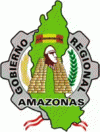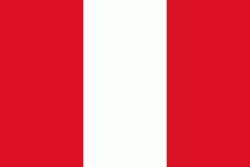Amazonas Region (Amazonas)
 |
 |
With a landscape of steep river gorges and mountains, Amazonas is the location of Kuelap, a huge stone fortress enclosing more than 400 stone structures; it was built on a mountain about 3,000 meters high, starting about 500 AD and was occupied to the mid-16th century. It is one of Peru's major archeological sites.
The department of Amazonas consists of regions covered by rainforests and mountain ranges. The rainforest zone predominates (72.93%) and it extends to the north over its oriental slope, up to the border with Ecuador in the summits of the Cordillera del Cóndor. The mountain range zone is located in the southern provinces of the Amazonas Region and it only includes 27.07% of its whole territorial surface.
One of the factors that help to give big importance to its geography is not only that the big valleys and plains of its rainforest zone are the closest to the Pacific Ocean, but also its connections with the routes of the coast are the lowest. This is because they use the Paso de Porculla (the mountain pass of Porculla) that is located at 2,144 m. This is the lowest pass of the whole Peruvian Andes to arrive to the Pan-American road system.
The vast and deep Marañón valley which constitutes one of the most important morphologic features of the region.
The Marañón valley crosses a big part of its territory and expands itself from south to north. It reaches its greatest width in the province of Bagua. It narrows when it crosses the Cordillera Oriental (Spanish for "eastern mountain range") in its most violent route towards the east, towards the lowest part of the Amazon. It crosses those wonderful canyons and natural porches called punkus, a Quechua word that means doors.
The Utkupampa valley which is the real axis of the department of Amazonas is located between 5° and 6° of south latitude and 78° and 79° of west longitude. It is longitudinally developed up to the Marañón River, in which it flowed at 400 m.
This zone is the principal center of production and human groups location. It is developed in four very pronounced sectors:
* Vertiente del Marañon (Marañon's spring), that has important quebradas (Seca, Bocana, Copallín Nuevo and Choloque).
* Valle Medio (the middle valley) that has eleven quebradas in its both borders.
Map - Amazonas Region (Amazonas)
Map
Country - Peru
 |
 |
| Flag of Peru | |
Peruvian territory was home to several cultures during the ancient and medieval periods, and has one of the longest histories of civilization of any country, tracing its heritage back to the 10th millennium BCE. Notable pre-colonial cultures and civilizations include the Caral-Supe civilization (the earliest civilization in the Americas and considered one of the cradles of civilization), the Nazca culture, the Wari and Tiwanaku empires, the Kingdom of Cusco, and the Inca Empire, the largest known state in the pre-Columbian Americas.
Currency / Language
| ISO | Currency | Symbol | Significant figures |
|---|---|---|---|
| PEN | Peruvian sol | S/ | 2 |
| ISO | Language |
|---|---|
| AY | Aymara language |
| QU | Quechua language |
| ES | Spanish language |


















